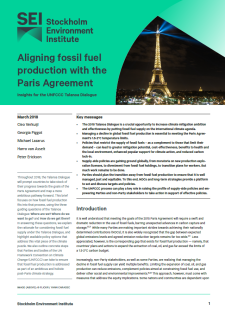
Throughout 2018, the Talanoa Dialogue will prompt countries to take stock of their progress towards the goals of the Paris Agreement and map a more ambitious pathway forward. It represents an opportunity for countries to include targets to limit fossil fuel supply alongside enhanced targets to reduce emissions and map out a managed decline in fossil fuel production through their long-term low-emissions development strategies (which the Paris Agreement invites them to submit by 2020).
Aligning fossil fuel production with the Paris Agreement, a brief released by the Stockholme Environment Institute (SEI), provides concrete suggestions for how the UN Framework Convention on Climate Change (UNFCCC) and Parties to the Paris Agreement can plan for a transition away from fossil fuels extraction and track whether progress aligns with Paris Agreement goals. A focus is placed on “supply-side” policies that limit the extraction and delivery of fossil fuels, such as fossil fuel subsidy reform and moratoria on new exploration, to complement more traditional “demand-side” policies that aim to limit their use. The brief also outlines actions that non-Party stakeholders can take to expedite the transition to a low-carbon economy, such as the World Bank’s commitment to end its financing of upstream oil and gas after 2019, emphasizing the importance of transition plans for fossil fuel-dependent workers and communities.
This brief is structured around the three guiding questions of Talanoa — a Pacific Island concept of inclusive, participatory and transparent dialogue: Where are we? Where do we want to go? and How do we get there? It tells the story, in summary form, of how these insights emerged and how they can guide future action.
